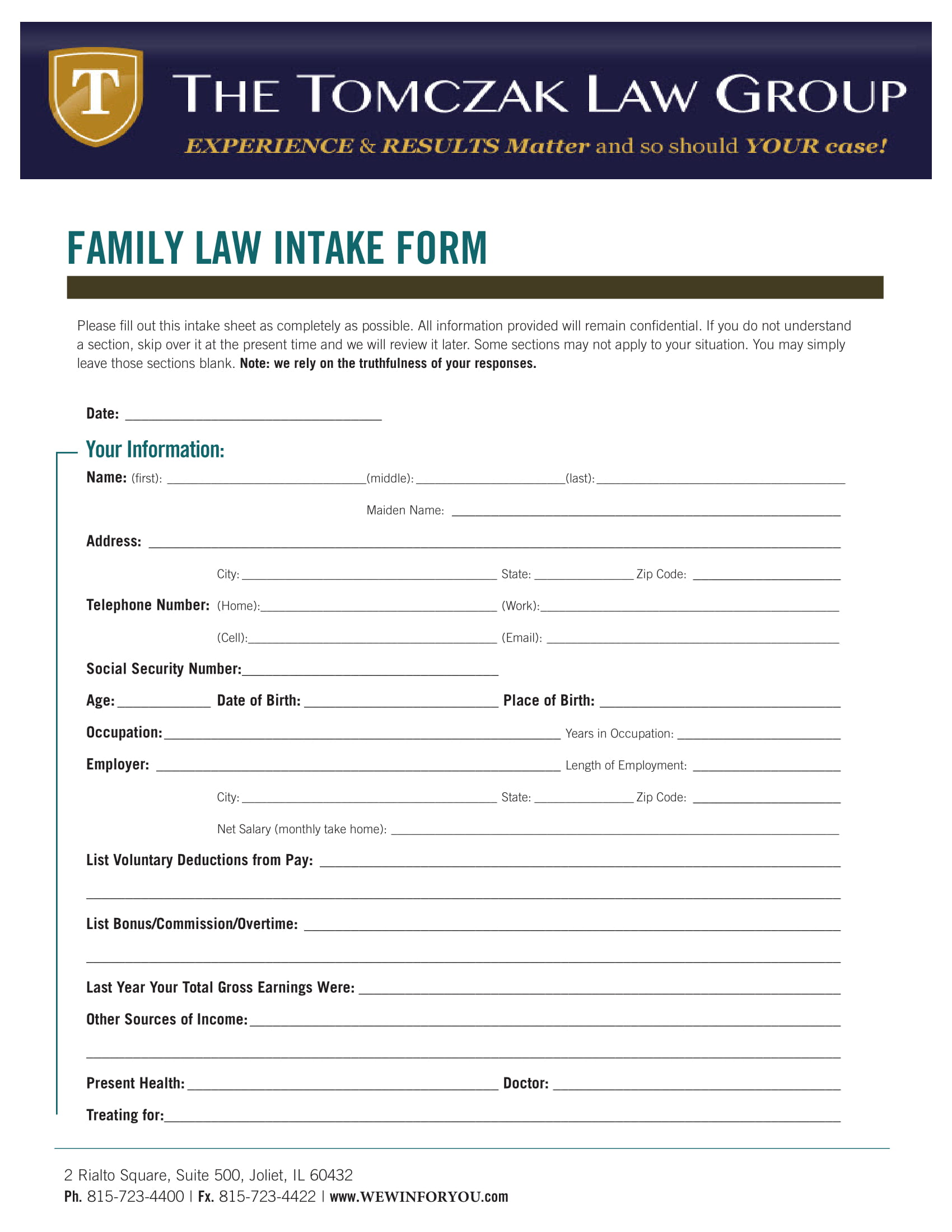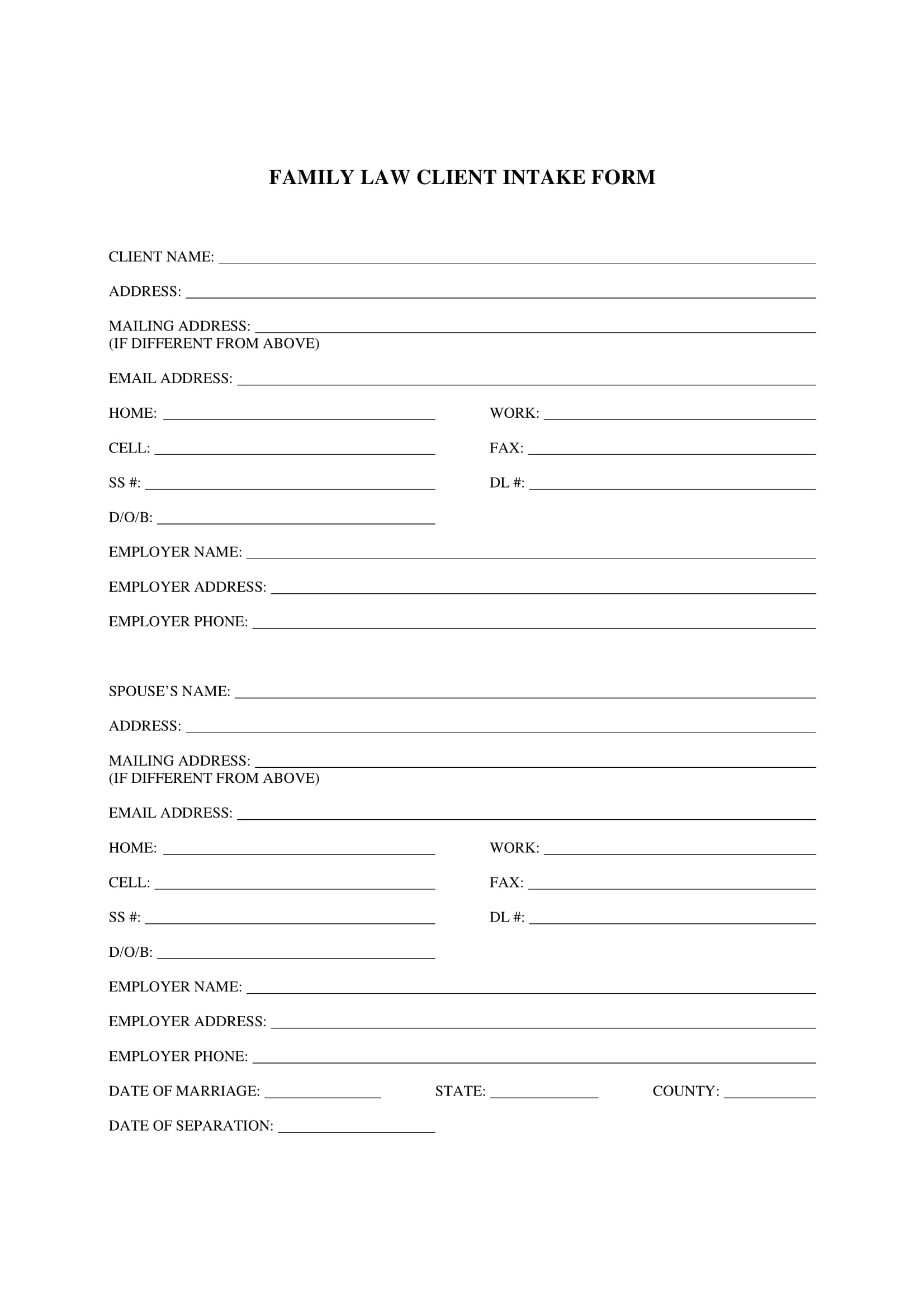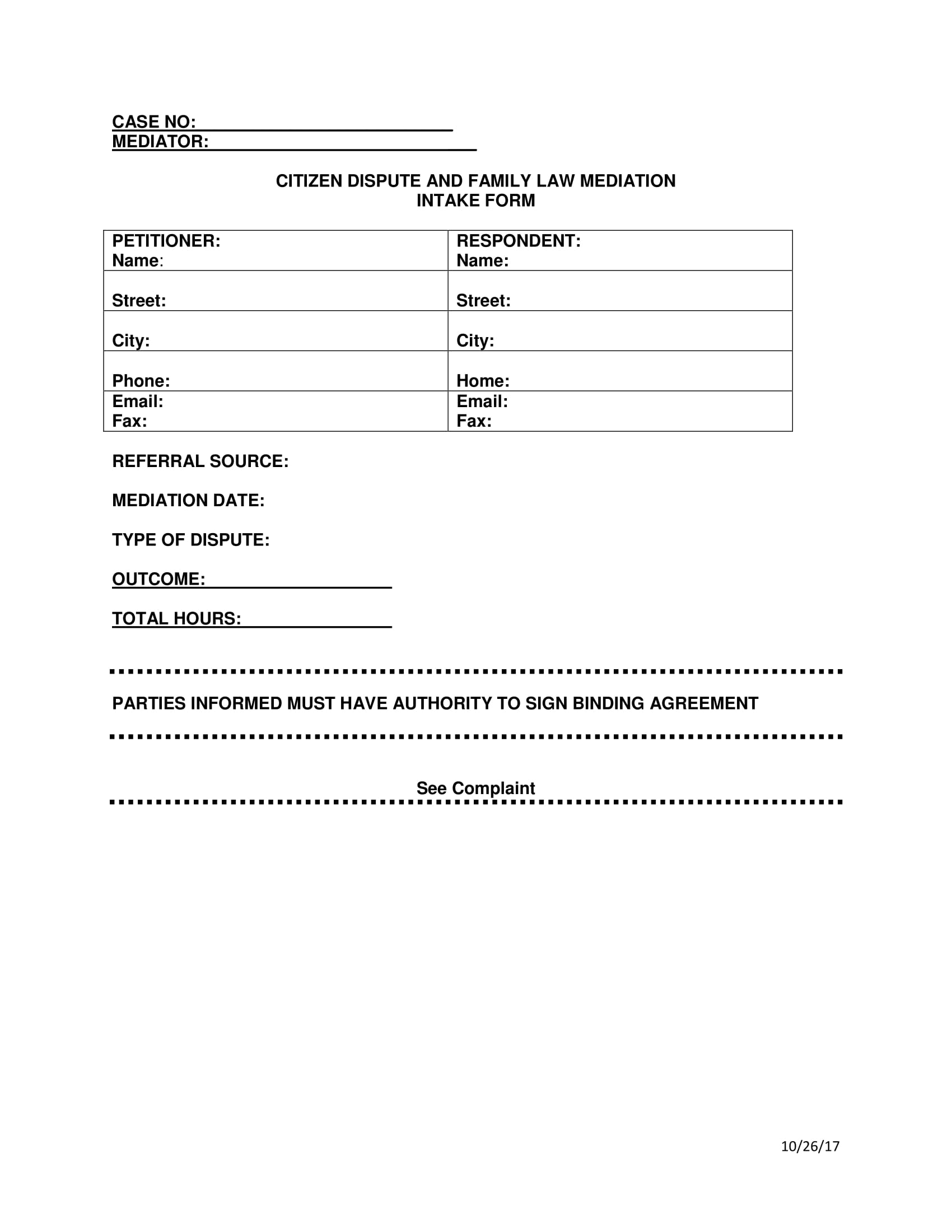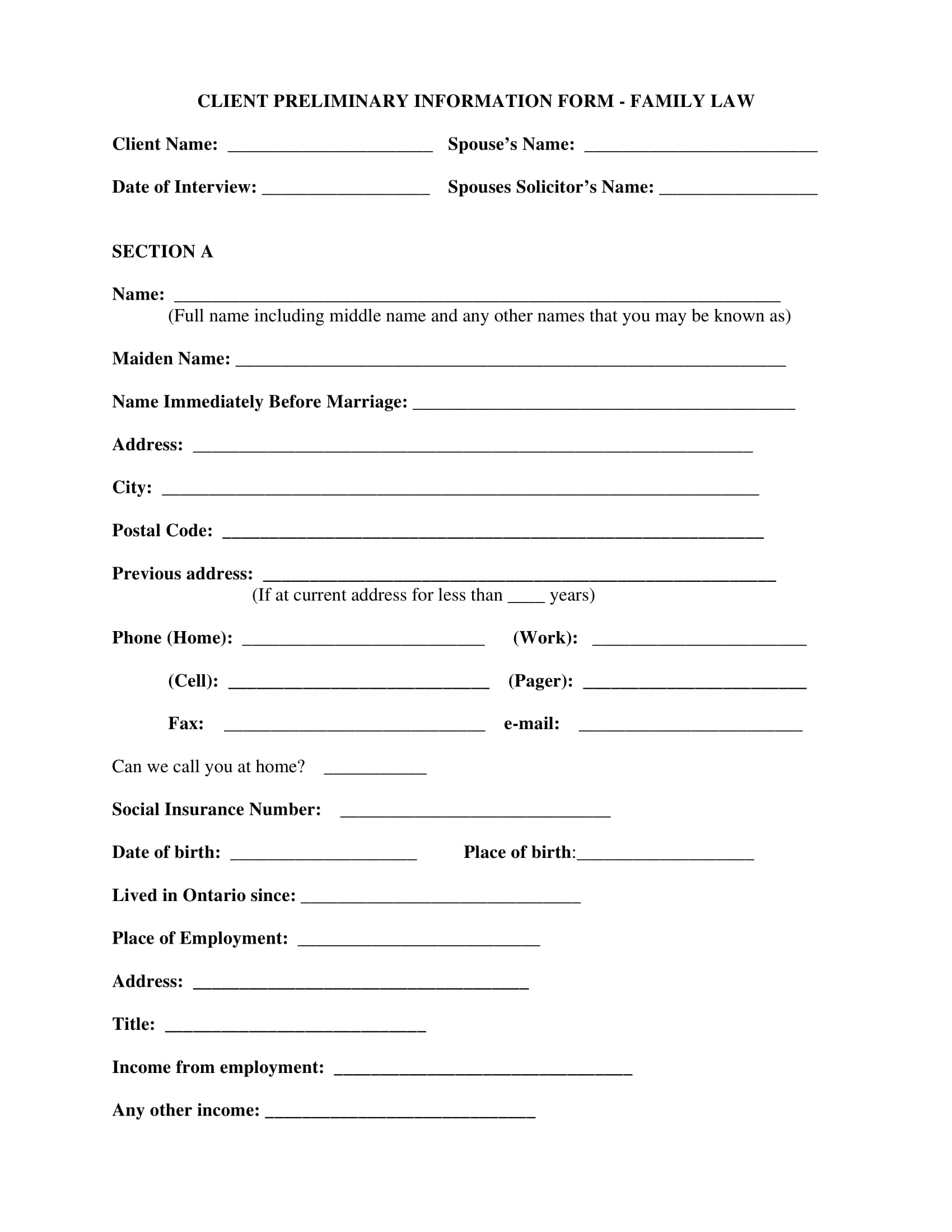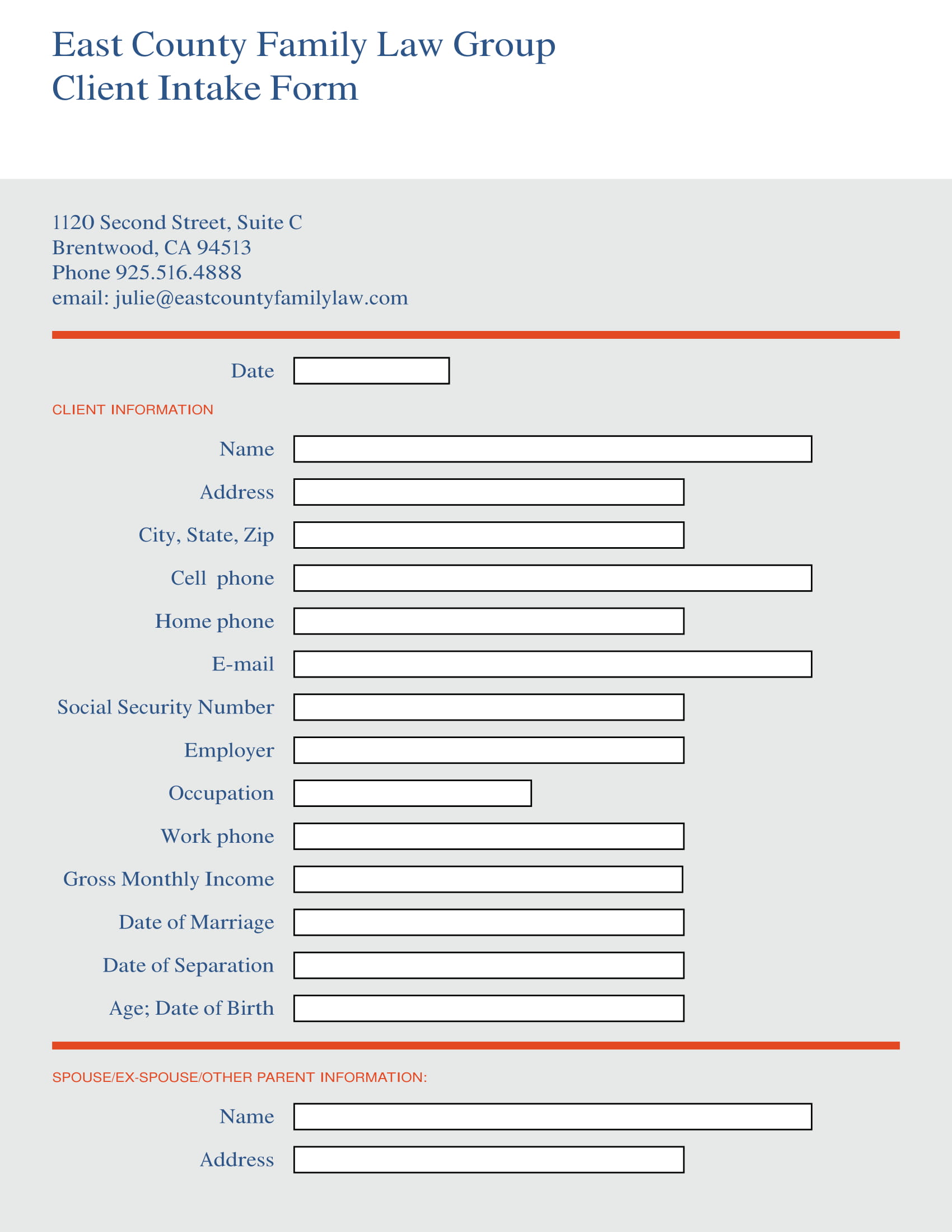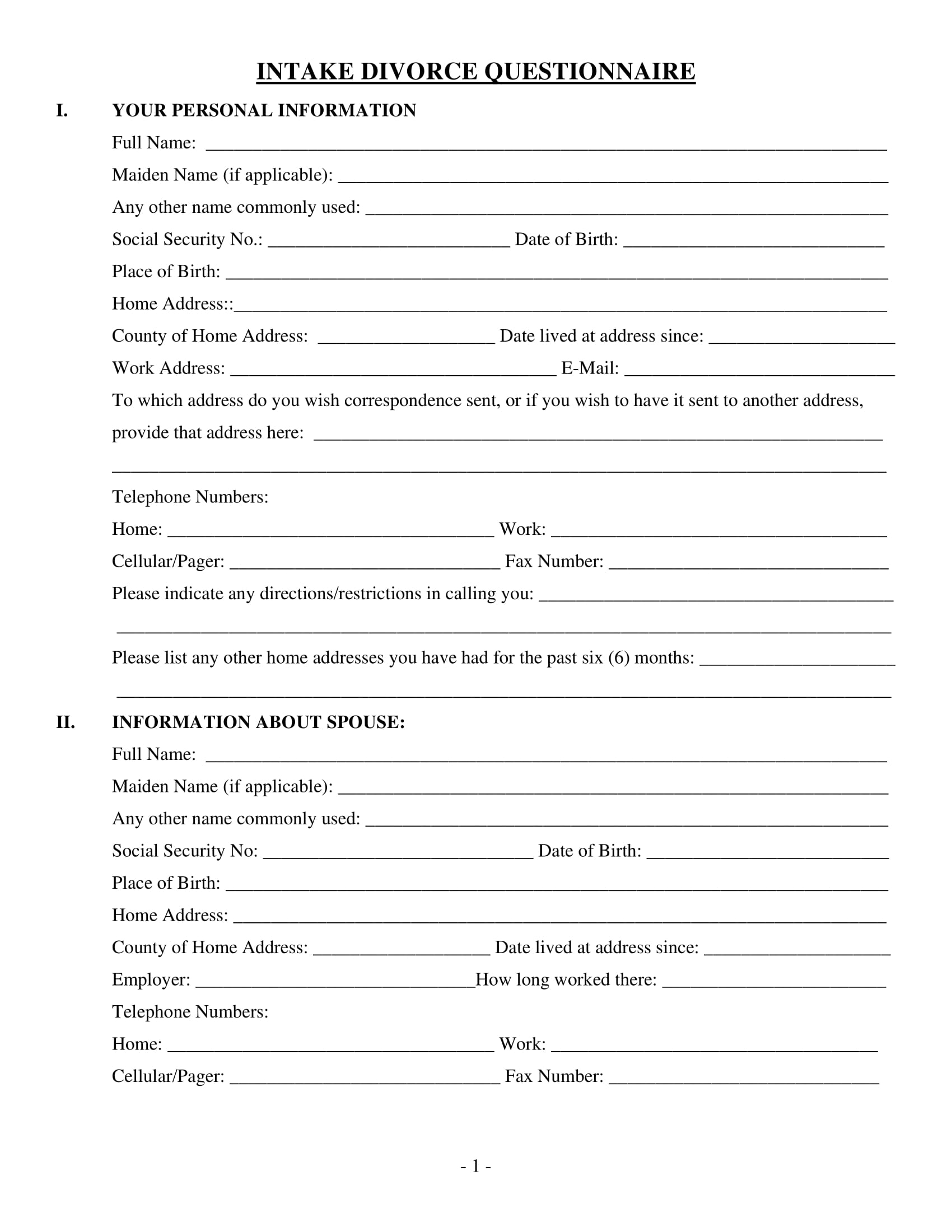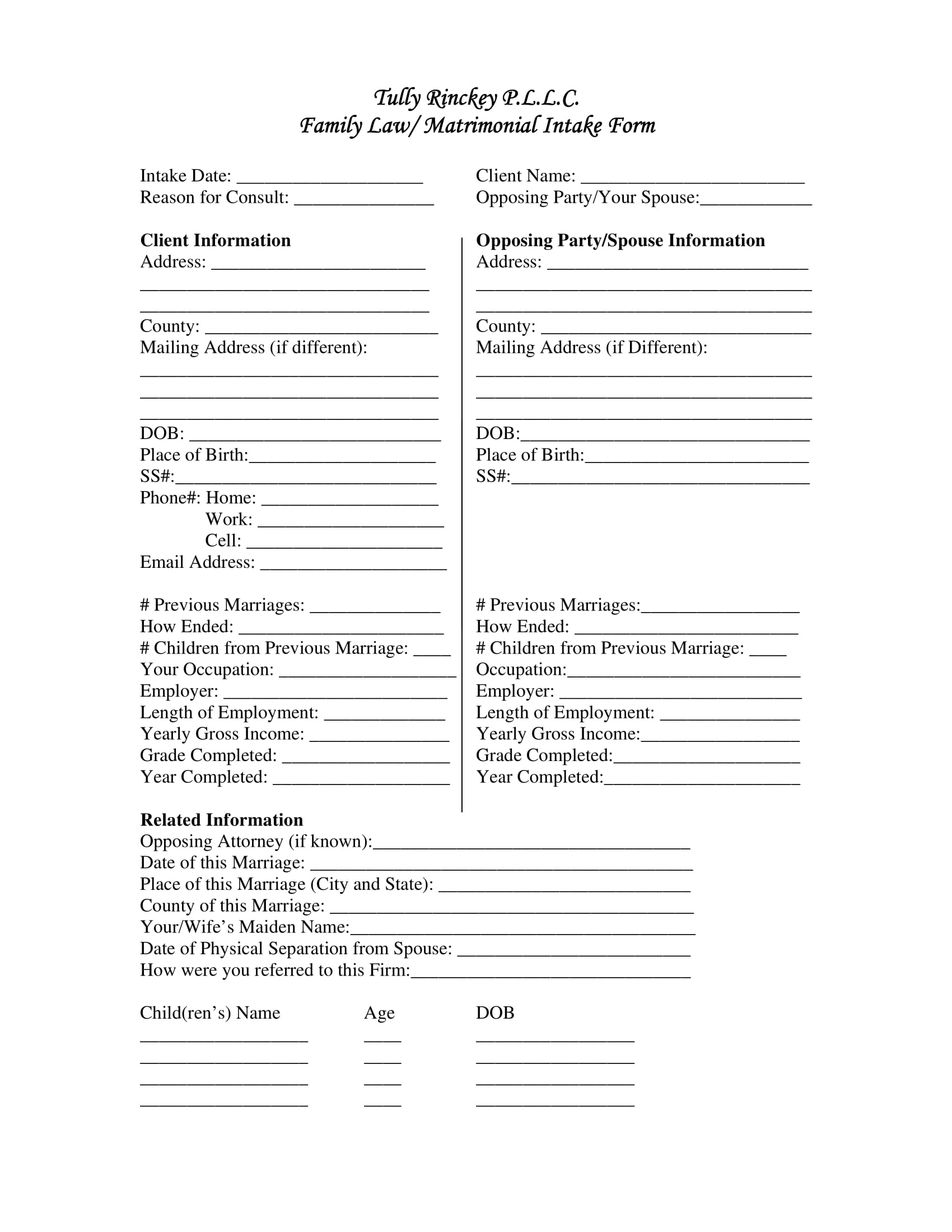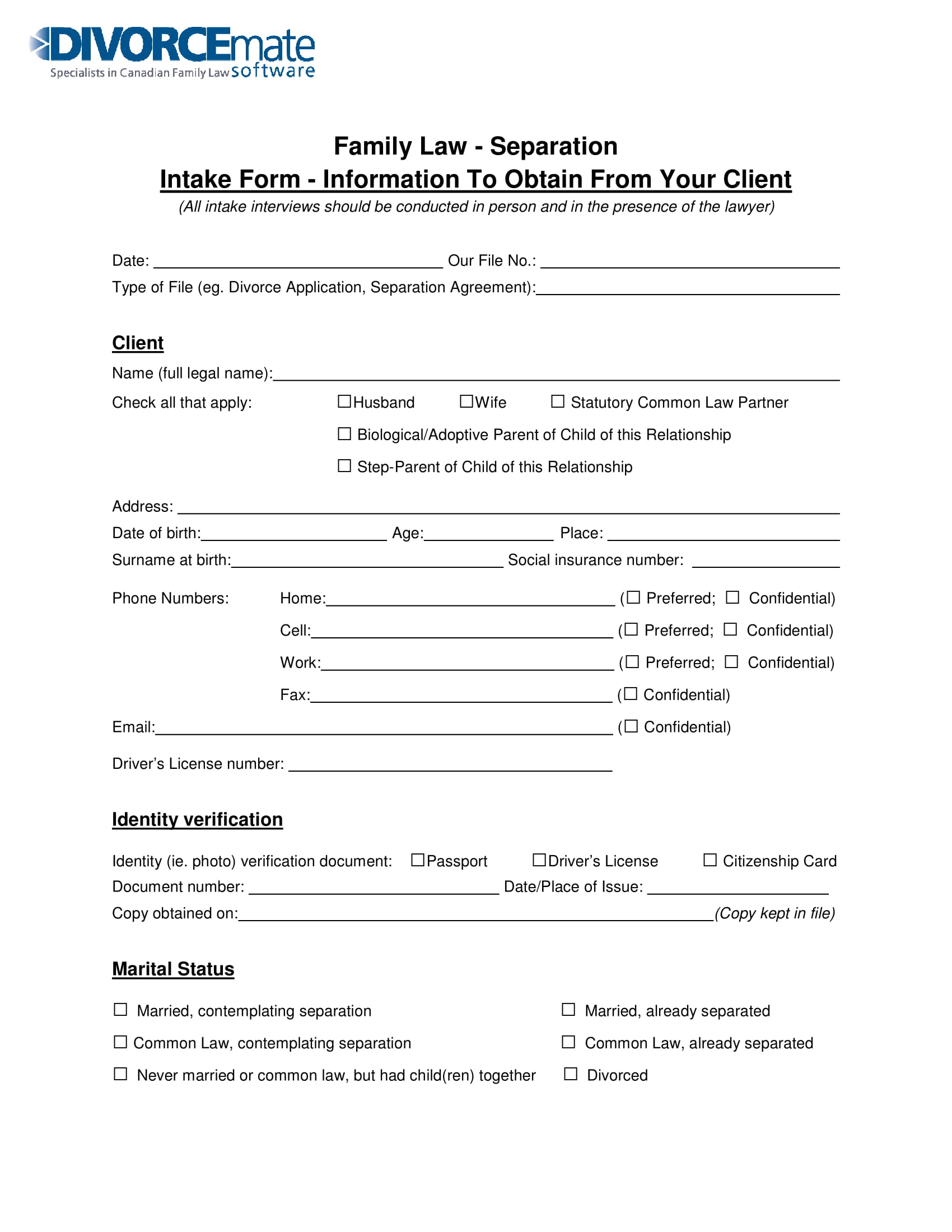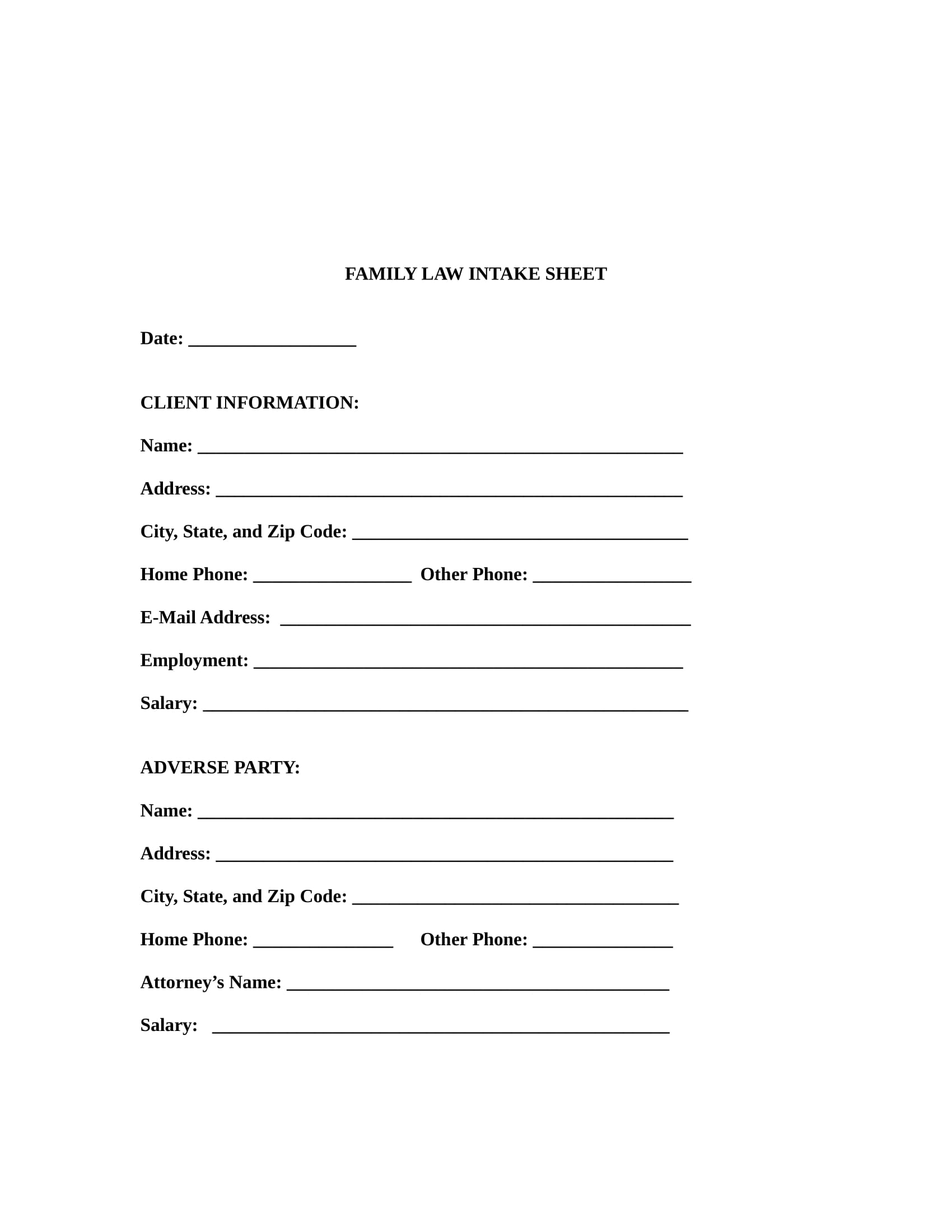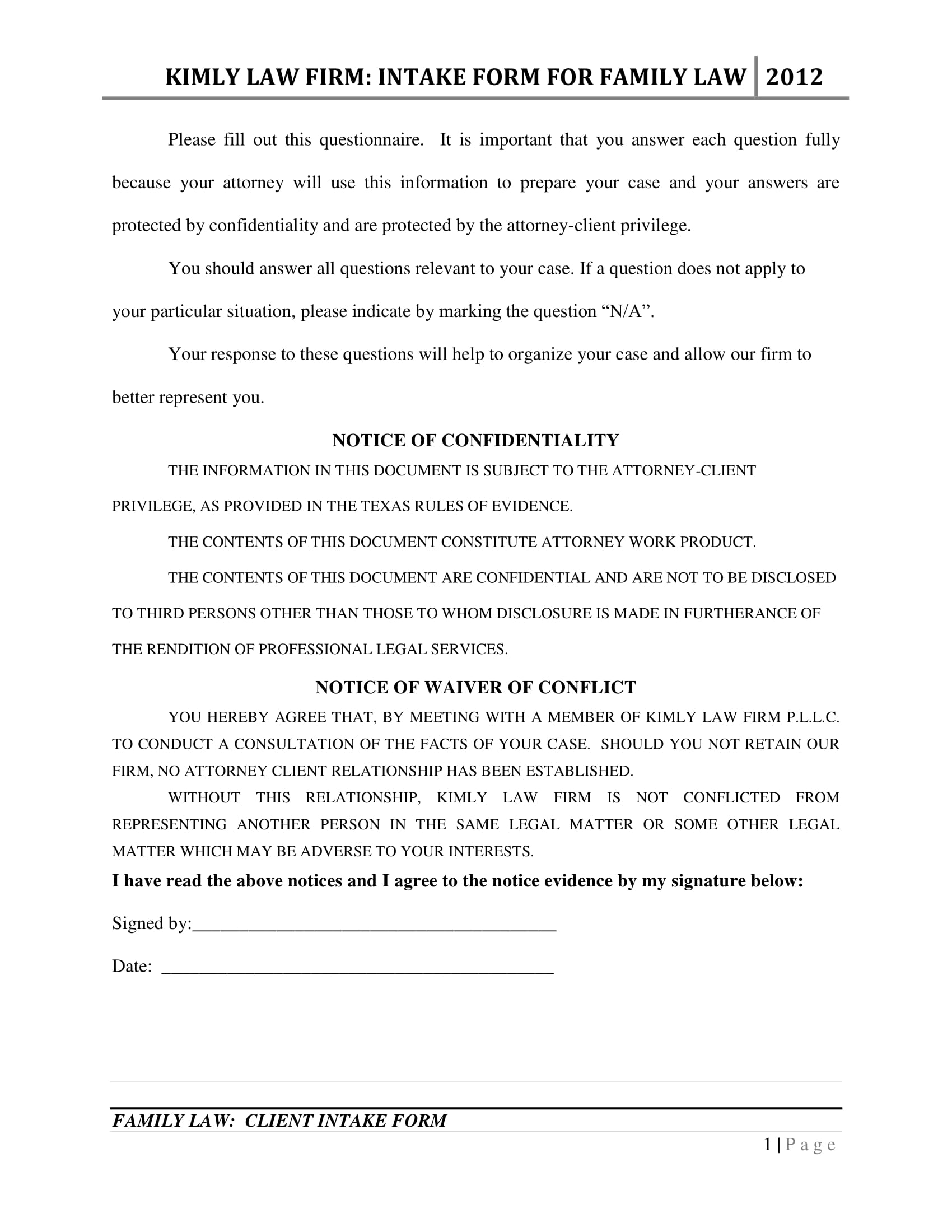Adoptions, marriage ceremonies, surrogacy, and paternity concerns are some of the subjects that are catered by family lawyers and family law consultants. The clients of these professionals will not only have to provide proof such as various certificate forms and documents, but also a completely filled out family law intake form.
Family Law Intake Form Sample
What Is a Family Law Intake Form?
A family law intake form is a document that is provided to a family lawyer’s client. The form is a tool for the lawyer to determine how he can address his client’s needs and concerns, as well as know the parties involved in the issue. Other documents must also be enclosed with this form such as the current financial statements made by the client and the deed forms that the client has for his properties. Nonetheless, the enclosed documents will highly depend on what type of legal concern will be addressed and catered by the consultant.
Family Law Client Intake Form
Varieties of Family Law Intake Forms
Since there are different legal cases that attorneys, lawyers, and consultants provide a service for, there are also various types of family law intake forms created to correspond each case. Listed below are the common types that are used nowadays by any family law legal consultant:
Citizen Dispute Family Law Intake Form – Some states and countries provide free citizen dispute settlement programs to their residents wherein the petitioner and the respondent will be given opportunities for them to settle their issues immediately. This program allows both parties to eliminate the need for filing a case to the court and paying large court costs to resolve the issues. With this, a citizen dispute family law intake form is provided to both parties to identify the responder, petitioner, and the mediator. The form also caters the information of when the mediation date will be, the type of dispute to be settled, the total number of hours needed to create a resolution, and an enclosed legal complaint submitted by the petitioner.
Citizen Dispute Family Law Intake Form
Family Law Client Preliminary Intake Form – There are different procedures that family law consultants require their clients to take and this includes completing a preliminary intake document. This family law client preliminary intake form will mainly have the general information of the client along with a few significant details to help the consultant in addressing the client’s concerns.
Family Law Client Preliminary Intake Form
Family Law Group Client Intake Form – This intake form has identical sections and fields to any common intake form; however, it differs on who will be using the document after the client fills out the sections. Upon the client’s completion of the form, this will be submitted to the family law consulting staff wherein they will be deciding who will handle the client. This is why it is important to indicate the date of when the form was submitted to assure that delays are omitted in providing the client’s requested services. Additionally, an indication of how the client heard about the law group is also indicated in the last section where the client will have to put a mark on the type of referral he received and the name of the person who referred the law group to him in order for the group to send a thank-you letter for the referral.
Family Law Group Client Intake Form
Family Law Intake Divorce Questionnaire Form – Divorce consulting attorneys use this form for their clients who aim to file a dissolution of their marriage. In a family law intake divorce questionnaire form, the client will have to provide his personal information along with his spouse’s details and the history of their marriage. Other details to be disclosed in this form includes the client and his spouse’s employment information, children, list of prior marriages and proceedings, and a questionnaire that focuses on determining the properties that the couple individually owns.
Family Law Intake Divorce Questionnaire Form
Family Law Matrimonial Intake Form – Family law consultants don’t only cater divorce cases from couples but also child custody consultations and other issues that arise in marriage. With this, a family law matrimonial intake form is the document that the client must complete with his details and marriage information. It is also essential that the client or the petitioner will indicate the name of his spouse’s attorney and the firm wherein the attorney belongs in order to acknowledge all the parties involved in the case.
Family Law Matrimonial Intake Form
Family Law Separation Intake Form – In contrary to a divorce, a separation agreement allows the couple to live apart from each other; however, they remain to be married to each other. With a family law separation intake form, the client can disclose the significant details of himself and his marriage. The client’s assets, liabilities, employment, and matrimonial residence information are also included on the form. Additionally, the deadlines for submitting a completed intake form is also stated at the end section of the form with the list of documents that the client needs to enclose to the form upon submission.
Family Law Separation Intake Form
How to Complete a Family Law Intake Form
Family law intake forms are easy to complete especially with the aid of the consulting staff. Below are the sections that family law clients must fill out in any family law intake form:
- Client information – This section indicates the full legal name of the client, current residential address, social security number, as well as the client’s contact details. Some intake forms will also demand the client to disclose his driver’s license number and legal certificate issuance details for providing sufficient identification to the consultant.
- Employment information – This mainly collects the name of the client’s employer, the address of the employer’s company, and the contact information of the company. The importance of having these details is to allow the consultant in conducting an employment verification to assure that the client is disclosing factual information about him. Additionally, the client’s gross income and the length of his employment from the day of signing an employment contract is also indicated in this section.
- Medical information – The details to be disclosed in this section are necessary for determining if the medical condition of the client is a factor that affects the client’s family-related issues and concerns. Basic medical information can include whether the client has an illness, disease, or any disability prior to the day of requesting for the family lawyer’s services.
- Spouse information – Since the intake form is intended to be used for clients who have family issues and concerns, it is essential for the client to indicate the name and the details of his spouse or marriage. The spouse’s employment details, prior marriages, debts, and properties are some of the information needed to be disclosed in this section.
- Children information – This section is only applicable to clients who have children. The children’s names, their dates of birth, current grade level in school, and the organizations that they are currently involved in are some of the details indicated in this section. On the other, if the client is not a parent to any child, then he will need to inform his lawyer or consultant and skip this information section.
- Property information – This is allotted for the client’s property description along with the property’s current market value and location. For each property claim, the client must be able to provide a proof such as a title or an ownership contract that indicates the client’s role in the property.
- Debts and liabilities information – Credit cards, loans, and even mortgages that the client currently has are the details to be indicated in this debt and liability information section. Specifically, the client’s debt value area stated along with its separation value and value at marriage.
- Additional questionnaire – This is the last section of the form wherein the client is presented with a set of questions relating to his relationship and marriage with his spouse. The common questions found in this section includes the specific issues that are continuous within the client’s marriage and the verbal agreements that he agreed on with his partner. Nonetheless, a comment or other information area can be a substitute for this section to allow the client in narrating his issues, concerns, and suggestions of how a resolution can be made for his family.
Family Law Intake Form in DOC
Significant Documents to be Enclosed with a Family Law Intake Form
Aside from the fields that are recommended to be completed by the client in a family law intake form, the client will also have to provide several types of documents to prove his claims and determine the limitations that he and the lawyer must observe as they begin their transaction. One of the most common documents that a client can provide is his financial statement in the current year. This is essential for proving his capacity to provide financing to his family and children.
Another document that is enclosed, not by the client, but by the family lawyer is a confidentiality agreement along with a waiver. The confidentiality agreement will indicate the rules and regulations that the client must follow such as avoiding discussions with other parties regarding the issue before a resolution is made.
Law Firm Family Law Intake Form
Basic Family Intake Form
Lastly, contract agreements and property deeds that the client has can also be enclosed on the form if the client has disclosed a list of owned properties. These documents will then be kept for documentation and for further analysis of the case.
Related Posts
-
Client Intake Form
-
FREE 21+ Counseling Intake Forms in PDF | MS Word
-
FREE 4+ Therapy Intake Forms in PDF | MS Word
-
FREE 4+ Project Intake Forms in PDF | MS Word
-
New Patient Intake Form
-
Massage Intake Form
-
Coaching Intake Form
-
FREE 4+ Event Planning Intake Forms in PDF | MS Word
-
FREE 7+ Medical Intake Forms in PDF
-
FREE 10+ Sample Assessment Intake Forms in MS Word | PDF

